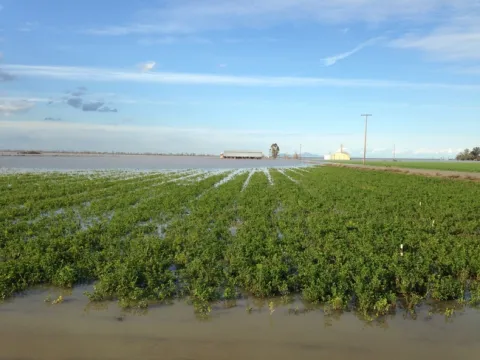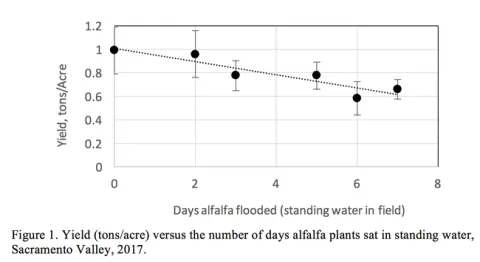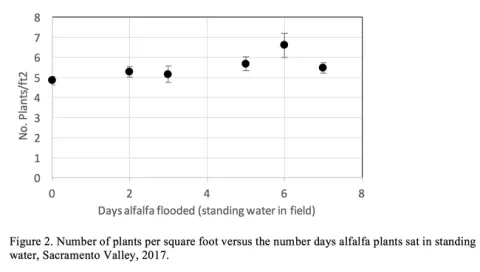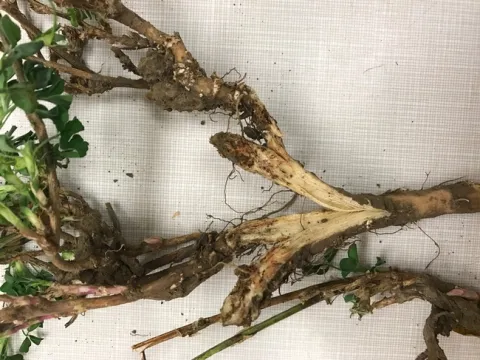There is little doubt that the heavy late rains we've seen in spring, 2019 in the northern part of California will reduce yields and quality for many alfalfa growers.
How much depends upon soil type and the flooding risk of individual fields and the health of the plants during this stress period.
Roots are often damaged during extensive wet periods, and the remaining roots need mostly time to recover as the weather improves.
When alfalfa is dormant and not growing, it's fairly tolerant of saturated soil conditions. When it begins to break dormancy, and it's cold and wet, plants will start growing, but slowly, making us wonder if there's going to be a reasonable first cutting.
However, when soils begin to warm and dry out, the plants will begin to grow rapidly. In years like this one with constant rain, one just has to be patient. Trying to push the plants into action by adding nitrogen (N) to the stand to try to get them growing is just throwing good money after bad. In saturated soil conditions, the plants and N-fixing nodules need air, not N (see our blog on, Does nitrogen assist alfalfa in recovering from flood damage?
Once soils have dried and plants are still growing slowly with signs of N deficiency (yellowish, stunted plants) that's a different story. A small amount of starter N (11-52-0) may be needed to get the stand growing until N-fixing nodules become active enough again, to supply the N needs of the plant (see our blog on, When is nitrogen fertilization of alfalfa beneficial? Almost never!). The phosphorus is also important for re-generating plants.
What happens when alfalfa is actively growing?
When alfalfa is actively growing and inundated by flood waters, it does not tolerate standing water, especially over the crowns. In a study in the Sacramento Valley in 2017, an alfalfa field was monitored for yield and stand persistence after flooding in late February (see photo of flooded alfalfa stand). Yields and stand counts were taken in April, June, and August that same season. Where water sat for 2-days, the stand recovered. However, where water sat for 3 to 5-days, yield declined by 20%; after 6 to 7-days of flooded conditions, yields declined by 40% by August (see Fig. 1).


Stand counts (number of plants per square foot) were not affected by flooding (see Fig. 2). Instead, yield loss was due to crown rot from standing water that created anaerobic conditions. The roots were fine, but the crowns were brown and spongy (see photo of alfalfa with crown rot). Not surprisingly, no definitive pathogens were isolated from the crowns by the UC Davis Plant Pathology Department; instead the rot was from a lack of oxygen that killed parts of the crown, with secondary pathogens invading the plant (not caused by common crown and root rot by the fungus Stagnospora).


Can one prepare for flooded conditions?
While we can't predict the weather, we can be familiar with our soils and be prepared with good agronomic practices to help overcome issues of saturated soil conditions. Watch for issues of seepage and don't plant alfalfa where there could be a high water table. In dry years, the alfalfa will grow well, with deep tap roots extending up to 6-ft. However, in wet years when the water comes up, the roots might be sitting in water, which will weaken and eventually kill the stand. In heavy soil, plant alfalfa on shallow beds so the water drains faster, away from the crowns. Also, choose varieties to plant that break dormancy later (for example February rather than January) so plants are not actively growing in heavy, cold, wet soils.
What can one do about water damage in seeding and established alfalfa stands?
We have several recommendations. Check out our blog post for how to handle these problem fields, Flooding and water-logging damage in alfalfa – What to do?

